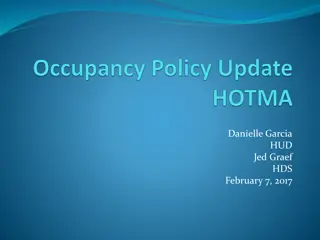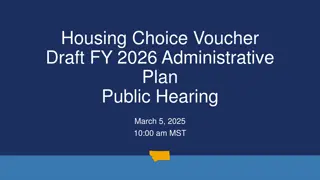
AHFA Program Guidelines: Income, Exclusions, and Certification Information
Explore the AHFA Program guidelines covering income hierarchy, nonrecurring income, exclusions from net family assets, and certification requirements. Learn about using HOTMA, certification dates, and income limitations until 2026.
Download Presentation

Please find below an Image/Link to download the presentation.
The content on the website is provided AS IS for your information and personal use only. It may not be sold, licensed, or shared on other websites without obtaining consent from the author. If you encounter any issues during the download, it is possible that the publisher has removed the file from their server.
You are allowed to download the files provided on this website for personal or commercial use, subject to the condition that they are used lawfully. All files are the property of their respective owners.
The content on the website is provided AS IS for your information and personal use only. It may not be sold, licensed, or shared on other websites without obtaining consent from the author.
E N D
Presentation Transcript
HOTMA Everyone must use HOTMA on this date. January 1, 2024 January 1, 2025 July 1, 2025 January 1, 2026
HOTMA January 1, 2024 Once AHFA is ready, which we are, you can begin to use HOTMA
HOTMA The following can be found on AHFA s website: HOTMA Certifications Imputed Income Limitation Passbook Savings Rate Until January 1, 2026, you can use pre- HOTMA regulations. However, you cannot use a combination of the two regulations.
Exclusions from Net Family Assets Exclusions can be found in the following: AHFA Compliance Manual IRS Notice H 2023-10 24 CFR Section 5.609(b)
Annual Income Includes all amounts received from all sources by each member of the family who is 18 years of age or older, the head of household, or spouse of the head of household, in addition to unearned income received by or on behalf of each dependent who is under 18 years of age. Annual income includes all amounts received, not the amount that a family may be legally entitled to receive but which they do not receive.
Nonrecurring Income Income that will not be repeated beyond the coming year (i.e., the 12 months following the effective date of the certification), based on information provided by the family, is considered nonrecurring income and is excluded from annual income. Income received as an independent contractor, day laborer, or seasonal worker is not excluded from income, even if the source, date, or amount of the income varies. Income that has a discrete end date and will not be repeated beyond the coming year during will be excluded from a family s annual income as nonrecurring income
Income Hierarchy 6, 5, 4, 3, 2, 1 Highest to Lowest
Income Hierarchy #6 Enterprise Income Verification (EIV) EIV is not allowed in the Housing Credit program
Income Hierarchy #5 Upfront Income Verification (UIV) using non-EIV system. Examples: Web-Based State Benefit Systems The Work Number truv Income/Assets (Gig Economy) Finicity Asset Verification Experian Income/Asset Verification Plaid Income/Asset Verification Argyle Income/Asset Verification
Income Hierarchy #4 Written, 3rdParty Verification Tenant-Provided Verification Example: Self-Employment Go Fund Me Account Veterans Benefits Pay Stubs Letter of Hire SSA Benefit Letter Bank Statements
Income Hierarchy #3 Written, 3rdParty Verification Form Traditional 3rdParty Verification A form completed by the 3rdparty by hand. (in writing or type-set)
Income Hierarchy #2 Oral 3rdParty Verification Contacting the Income Source via telephone or in-person This type must be documented in the file with the following: Date and Time of the call or visit Name of Contact Person and their telephone # Confirmed Information
Income Hierarchy #1 Self-Certification (not a 3rdparty verification) Use as a last resort when unable to obtain any type of 3rdparty verification Must Document the File with the following: Why 3rdparty verification was not available Not required to be notarized, but it is recommended to use language to ensure the individual knows the consequences of knowingly providing false information
Assets Net family assets are defined as the net cash value of all assets owned by the family, after deducting reasonable costs that would be incurred in disposing of real property, savings, stocks, bonds, and other forms of investment, except as excluded. Determining Net Family Assets Notice H 2023-10, page 44-46 Exclusions from Net Family Assets AHFA Compliance Manual Notice H 2023-10, page 46-47 Necessary and Non-Necessary Personal Property Notice H 2023-10, page 47-48
Necessary and Non-Necessary Personal Property (NNPP) Necessary personal property is excluded from net family assets. Non-necessary personal property with a combined value greater than the Imputed Income Limitation (currently $51,600) is considered part of net family assets.
Necessary and Non- Necessary Personal Property (NNPP) All Assets are categorized as either: Real Property Land Home Personal Property Boats Bank Account(s)
Necessary and Non-Necessary Personal Property (NNPP) Necessary Personal Property Items that are essential to the family for the following: Maintenance, Use, and Occupancy of the Premises as a Home Necessary for Employment Necessary for Education Necessary for Health and Wellness Do not include bank accounts, other financial investments, or luxury items
Necessary and Non-Necessary Personal Property (NNPP) Examples of each list can be found: Notice H 2023-10, page 48 (this is not an exhaustive list).
Retirement Accounts Most retirement accounts such as: IRA Employer Retirement Plan Retirement Plan for a Self-Employed Individual(s) Do not count when calculating Assets. You do count if the applicant/resident is receiving distributions, but this amount would be a part of the Gross Income.
All assistance received under 479B of the HEA by students participating in the Public Housing or non Section 8 programs is excluded from income. Student Financial Assistance Non- Section 8 Other student financial assistance received by the student that, either by itself or in combination with HEA assistance, exceeds the actual covered costs is not excluded from income.
What are Covered Costs? Tuition Books Supplies Room and Board Fees charged to a Student by an Institution of Higher Learning Student Financial Assistance
Student Financial Assistance Non- Section 8 Steps in Calculating Amount of Other Student Financial Assistance Step 1: Subtract the amount received under section 479B of the HEA from the actual covered costs to arrive at the amount of actual covered costs exceeding section 479B assistance. Step 2: Subtract the actual covered costs exceeding section 479B assistance from the amount of other student financial assistance to arrive at the amount of student financial assistance included in income.
Student Financial Assistance Non-Section 8
If the student is the head of household, co-head, or spouse and is under the age of 23 or without dependent children, then both the assistance received under 479B of the HEA and other student financial assistance received by the student will be counted as income to the extent that it exceedsthe total of tuition and any other required fees and charges. Student Assistance Section 8 In contrast, the student financial assistance received by a Section 8 student who is the head of household, spouse, or co-head of household and is over the age of 23 with dependent children will be treated in a manner identical to the student financial aid received by students who participate in non Section 8 programs
There are two steps required as part of the calculation for Section 8 students: Step 1 -Determine the student s relationship to the household, age, and whether they have dependent children Student Assistance Section 8 Step 2 -Based on the result of the first step; calculate whether any excess student financial assistance should be included in the family s income. 1. If the student is the head of household, co-head, or spouse and is 23 or younger or does not have dependent children, then 479B assistance will be part of the total equation. 2. If the student is over 23 with dependent children, then the calculation will be identical for non Section 8 students
Student Assistance Section 8
John is a 22-year-old full-time student without dependent children. Since John is a Section 8 participant head of household who is not over 23 with dependent children, the Owner follows the Appropriations Act policy to determine if John receives student financial assistance in excess of tuition from both HEA and other sources. John received the following amounts to cover his first year of college: Federal Pell Grant: $12,000 University Scholarship: $22,000 City Scholarship: $3,000. Total assistance received under 479B of HEA: $12,000 (Federal Pell Grant) Total other student financial assistance received: $25,000 (Scholarships) Total student financial assistance from all sources: $37,000 Total tuition + required fees and charges: $27,000 Subtract the total cost of tuition + required fees and charges from the total amount of student financial assistance: $37,000 $27,000 = $10,000 The total amount of student financial assistance from all sources received by John exceeds the total amount of tuition and required fees and charges. Excess student financial assistance: $10,000 Amount of student financial assistance included in John s income: $10,000 Student Assistance Section 8
Alimony & Child Support Annual income includes all amounts received, not the amount that a family may be legally entitled to receive but which they do not receive. For example, a family s child-support or alimony income must be based on payments received, not the amounts to which the family is entitled by court or agency orders.
Bank Statement Owners are required to obtain a minimum of two current and consecutive pay stubs for determining annual income from wages
Owners are required to obtain a minimum of two current and consecutive pay stubs for determining annual income from wages Pay-Stubs
Passbook Rate HUD will annually publish the passbook rate and Imputed Income Limitation. AHFA will post the HUD Passbook Rate & Imputed Income Limitation in the Compliance -Addendums, Certifications & Verifications section on the AHFA website. For 2025: The HUD Passbook Rate is 0.45% The Imputed Income Limitation is $51,600



